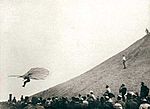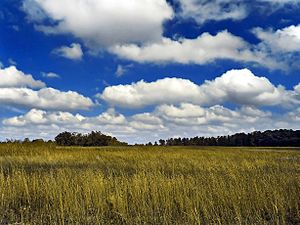Hang gliding facts for kids

Hang gliding is an amazing air sport! It's where a pilot flies a super light aircraft called a hang glider. These gliders don't have an engine. You launch them by foot, often running down a hill.
Most modern hang gliders are made from strong but light materials. They have a frame of aluminium alloy or composite and a fabric wing. The pilot lies in a special harness. This harness hangs from the glider's frame. To steer, the pilot shifts their body weight. This moves the glider in the air.
In the past, pilots could only glide down small hills. Their gliders weren't very powerful. But today, technology has changed everything! Pilots can now fly for hours. They can go thousands of metres high. They use rising air currents to gain altitude. They can even do cool aerobatics. Some pilots fly hundreds of kilometres across the country!
Contents
The History of Hang Gliding

Early glider designs were often not very safe. This was because pioneers didn't fully understand how bird wings worked. They needed more scientific knowledge.
Early Glider Designs and Pioneers
Around the 1880s, big steps forward were made. These led to the first truly useful gliders. Otto Lilienthal was a key figure. In the 1890s, he built gliders that he could control. He could even use rising air from hills to stay up.
Lilienthal carefully wrote down all his work. This greatly helped later designers. Because of this, he is a very famous early aviation pioneer. His gliders were controlled by shifting body weight. This is similar to how modern hang gliders work. He was attached to the glider by his shoulders. He swung his feet to steer.
Developing the Modern Hang Glider
In the early 1900s, hang gliding continued to grow. In 1904, Jan Lavezzari flew a glider with a stiffened flexible wing. He launched it from Berck Beach in France. By 1910, a gliding club in Breslau showed a new design. It had a triangle control frame. The pilot hung behind this triangle.
Many magazines shared plans for building biplane hang gliders. People in several countries built and flew them. This was thanks to Octave Chanute and his designs. In 1909, Carl S. Bates wrote an important "how-to" article. Many people built their first hang gliders using his plans. Later, in 1940, Volmer Jensen created the VJ-11. This biplane hang glider allowed safe control in all directions.
The Rogallo Wing and Its Impact
A huge step came in 1948. Francis Rogallo and Gertrude Rogallo got a patent for a flexible kited wing. This was called the flexible wing or Rogallo wing. In 1957, the American space agency NASA started testing it. They wanted to use it to bring space capsules like Gemini back to Earth.
The Rogallo wing was simple to design and build. It could fly slowly and land gently. Hang glider fans quickly noticed these features. Between 1960 and 1962, Barry Hill Palmer used the flexible wing idea. He made foot-launched hang gliders with different ways to control them. In 1963, Mike Burns used the flexible wing to build a kite-hang glider. He called it the Skiplane.
Also in 1963, John W. Dickenson used the flexible wing idea. He made another water-ski kite glider. For this invention, the Fédération Aéronautique Internationale gave Dickenson a special award in 2006. He is recognized for inventing the modern hang glider.
How Hang Gliders Stay in the Air

A hang glider is always slowly moving downwards through the air. But pilots can stay up for hours! They do this by finding and flying in areas where air is rising. Once a pilot learns this skill, they can fly long distances. This is called cross-country (XC) flying.
Rising air comes from a few main sources:
Using Thermals to Climb
The most common way to get lift is from thermals. The sun heats the ground. The ground then heats the air above it. This warm air rises in columns, like invisible elevators. These are thermals.
Pilots learn to spot places that create thermals. They also look for signs of thermals. These include soaring birds, puffy clouds, lines of clouds, dust devils, and hazy areas. Most gliders also have a special tool called a variometer. This tool shows (and often beeps) when you are in rising or sinking air. Once a pilot finds a thermal, they circle inside it. This helps them gain height. Sometimes, thermals line up with the wind. This creates "cloud streets." Pilots can fly long, straight distances by staying in these lines of rising air.
Ridge Lift for Soaring
Ridge lift happens when wind hits a mountain, cliff, or hill. The air is forced upwards by the obstacle. Gliders can climb in this rising air. They fly back and forth along the side of the mountain. Another name for flying with ridge lift is slope soaring.
Mountain Waves and Convergence
The third main type of lift is lee waves. These happen near mountains. The mountain changes the airflow. This creates waves in the air. These waves have areas of rising and sinking air. The top of these waves often has special lens-shaped clouds.
Another type of lift is convergence. This is where two air masses meet. A good example is a sea-breeze front. Sometimes, very rare weather events like Morning Glory clouds in Australia are also used by glider pilots.
Related pages
Images for kids








